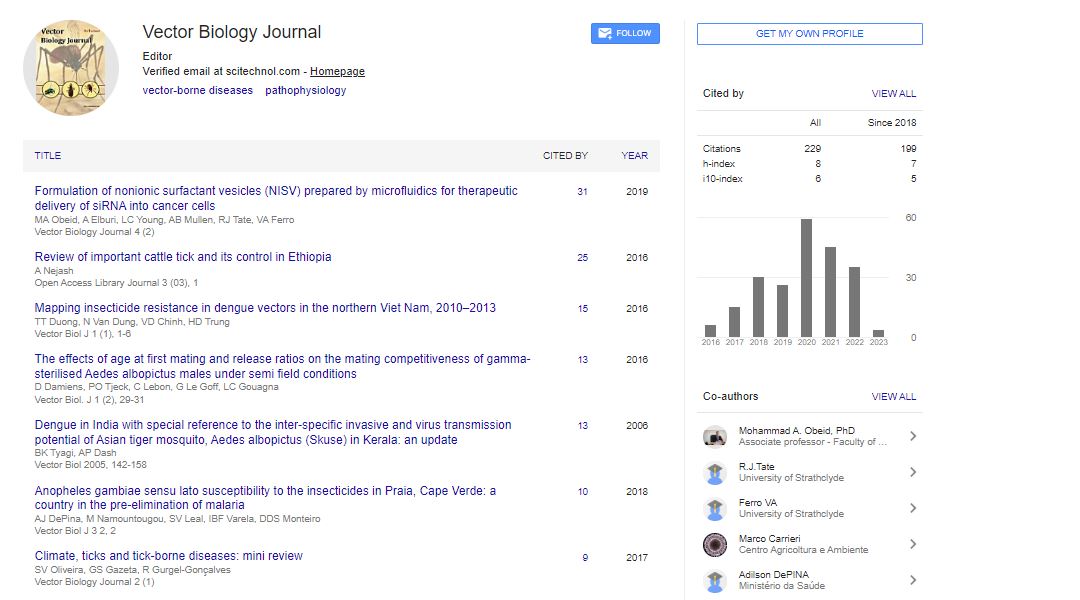Commentary, Vector Biol Vol: 8 Issue: 2
The Global Impact of Chikungunya: A Growing Public Health Concern
Mariene Lima*
1Department of Microbiology and Immunology, University of Texas Medical Branch, Galveston, USA
*Corresponding Author: Mariene Lima,
Department of Microbiology and
Immunology, University of Texas Medical Branch, Galveston, USA
E-mail: lima_mariene900@uit.edu
Received date: 30 May, 2023, Manuscript No. VBJ-23-107297;
Editor assigned date: 02 June, 2023, PreQC No. VBJ-23-107297 (PQ);
Reviewed date: 16 June, 2023, QC No. VBJ-23-107297;
Revised date: 23 June, 2023, Manuscript No. VBJ-23-107297 (R);
Published date: 30 June, 2023 DOI: 10.4172/2473-4810.1000264
Citation: Lima M (2023) The Global Impact of Chikungunya: A Growing Public Health Concern. Vector Biol 8:2.
Description
Chikungunya is a viral disease transmitted to humans by mosquitoes. The word "Chikungunya" originates from the Makonde language of Tanzania, meaning "to become contorted" or "to walk bent over." This name aptly describes the severe joint pain and arthritic symptoms associated with the disease. Chikungunya is caused by the Chikungunya Virus (CHIKV), a member of the Togaviridae family. In recent years, it has emerged as a significant global health concern due to its rapid spread and debilitating symptoms.
Chikungunya is primarily transmitted to humans through the bite of infected Aedes mosquitoes, particularly Aedes aegypti and Aedes albopictus. These mosquitoes are active during the day and commonly breed in stagnant water, making urban areas susceptible to outbreaks. While human-to-human transmission can occur through the exchange of bodily fluids, it is less common. Additionally, vertical transmission from an infected mother to her newborn during childbirth has been reported.
After an incubation period of 2 to 12 days, Chikungunya typically manifests with a sudden onset of symptoms. The most common clinical features include high fever, severe joint pain (arthralgia), muscle pain (myalgia), headache, fatigue, and rash. The joint pain is often debilitating, affecting multiple joints symmetrically and persisting for weeks or months. Other symptoms can include swelling, nausea, vomiting, and conjunctivitis. While the disease is rarely fatal, it can significantly impact the quality of life of affected individuals, particularly the elderly, pregnant women, and those with underlying health conditions. The diagnosis of Chikungunya is based on clinical symptoms, travel history, and laboratory tests. In the acute phase of the illness, the detection of CHIKV RNA through Reverse Transcription-Polymerase Chain Reaction (RT-PCR) is the most reliable method. Serological tests, such as Enzyme-Linked Immunosorbent Assay (ELISA), can be used in the later stages to detect the presence of antibodies against CHIKV. It is crucial to differentiate Chikungunya from other mosquito-borne diseases like dengue and Zika, as they share similar symptoms.
There is currently no specific antiviral treatment for Chikungunya. Management primarily focuses on relieving symptoms and providing supportive care. Analgesics, Nonsteroidal Anti-Inflammatory Drugs (NSAIDs), and antipyretics are commonly used to alleviate pain, reduce fever, and control inflammation. Rest, hydration, and physical therapy may help with joint symptoms. In severe cases, hospitalization may be required to monitor complications and provide intravenous fluids and pain relief. Preventing mosquito bites during the acute phase is essential to avoid further spread of the disease.
Prevention and control of Chikungunya primarily rely on mosquito control measures and public health interventions. These include eliminating mosquito breeding sites by removing standing water, using insecticides, and implementing vector control strategies. Community education and awareness campaigns play a crucial role in promoting personal protective measures, such as using insect repellents, wearing protective clothing, and using bed nets. Effective surveillance systems for early detection and response are also vital to control outbreaks and limit the spread of the disease.
Chikungunya outbreaks have a significant impact on affected communities, both in terms of public health and socio-economic consequences. The burden of the disease falls disproportionately on low-income populations with limited access to healthcare services. The high morbidity, loss of productivity, and healthcare expenses associated with Chikungunya can strain already fragile healthcare systems, particularly in resource-limited settings. Outbreaks can also lead to decreased tourism and economic losses in affected regions. Additionally, the long-term complications, such as chronic joint pain and disability, can further impair the quality of life and livelihoods of individuals and communities.
Chikungunya continues to pose a global health threat due to its widespread distribution and the potential for outbreaks in new regions. The combination of effective mosquito control measures, early detection, and appropriate public health interventions are essential for preventing and managing Chikungunya. International collaborations and research efforts are crucial for developing effective vaccines and antiviral treatments. By addressing the burden of Chikungunya, we can alleviate the suffering of affected individuals and reduce the socioeconomic impact on communities worldwide.
 Spanish
Spanish  Chinese
Chinese  Russian
Russian  German
German  French
French  Japanese
Japanese  Portuguese
Portuguese  Hindi
Hindi 